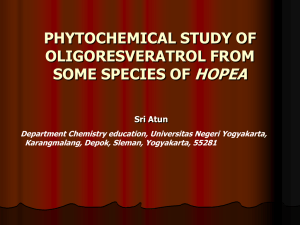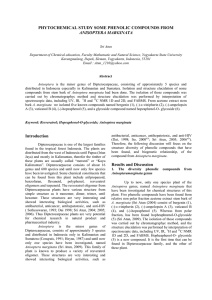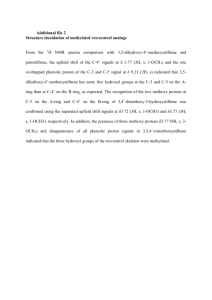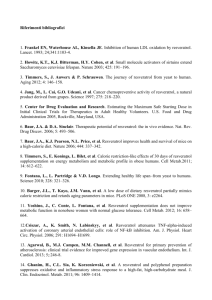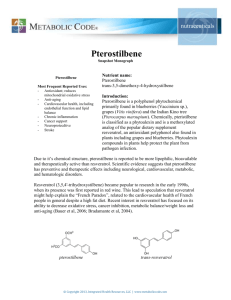Phytochemical Study of Oligoresveratrol from hopea Sri Atun
advertisement
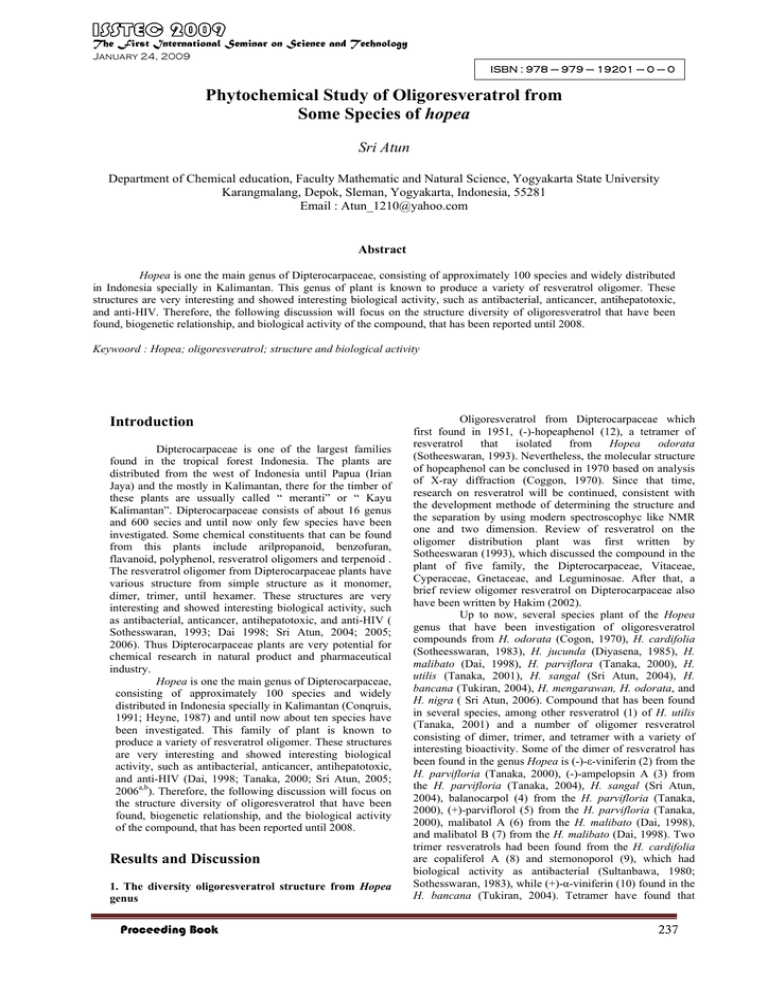
The First International Seminar on Science and Technology January 24, 2009 ISBN : 978 – 979 – 19201 – 0 – 0 Phytochemical Study of Oligoresveratrol from Some Species of hopea Sri Atun Department of Chemical education, Faculty Mathematic and Natural Science, Yogyakarta State University Karangmalang, Depok, Sleman, Yogyakarta, Indonesia, 55281 Email : Atun_1210@yahoo.com Abstract Hopea is one the main genus of Dipterocarpaceae, consisting of approximately 100 species and widely distributed in Indonesia specially in Kalimantan. This genus of plant is known to produce a variety of resveratrol oligomer. These structures are very interesting and showed interesting biological activity, such as antibacterial, anticancer, antihepatotoxic, and anti-HIV. Therefore, the following discussion will focus on the structure diversity of oligoresveratrol that have been found, biogenetic relationship, and biological activity of the compound, that has been reported until 2008. Keywoord : Hopea; oligoresveratrol; structure and biological activity Introduction Dipterocarpaceae is one of the largest families found in the tropical forest Indonesia. The plants are distributed from the west of Indonesia until Papua (Irian Jaya) and the mostly in Kalimantan, there for the timber of these plants are ussually called “ meranti” or “ Kayu Kalimantan”. Dipterocarpaceae consists of about 16 genus and 600 secies and until now only few species have been investigated. Some chemical constituents that can be found from this plants include arilpropanoid, benzofuran, flavanoid, polyphenol, resveratrol oligomers and terpenoid . The resveratrol oligomer from Dipterocarpaceae plants have various structure from simple structure as it monomer, dimer, trimer, until hexamer. These structures are very interesting and showed interesting biological activity, such as antibacterial, anticancer, antihepatotoxic, and anti-HIV ( Sothesswaran, 1993; Dai 1998; Sri Atun, 2004; 2005; 2006). Thus Dipterocarpaceae plants are very potential for chemical research in natural product and pharmaceutical industry. Hopea is one the main genus of Dipterocarpaceae, consisting of approximately 100 species and widely distributed in Indonesia specially in Kalimantan (Conqruis, 1991; Heyne, 1987) and until now about ten species have been investigated. This family of plant is known to produce a variety of resveratrol oligomer. These structures are very interesting and showed interesting biological activity, such as antibacterial, anticancer, antihepatotoxic, and anti-HIV (Dai, 1998; Tanaka, 2000; Sri Atun, 2005; 2006a,b). Therefore, the following discussion will focus on the structure diversity of oligoresveratrol that have been found, biogenetic relationship, and the biological activity of the compound, that has been reported until 2008. Results and Discussion 1. The diversity oligoresveratrol structure from Hopea genus Proceeding Book Oligoresveratrol from Dipterocarpaceae which first found in 1951, (-)-hopeaphenol (12), a tetramer of resveratrol that isolated from Hopea odorata (Sotheeswaran, 1993). Nevertheless, the molecular structure of hopeaphenol can be conclused in 1970 based on analysis of X-ray diffraction (Coggon, 1970). Since that time, research on resveratrol will be continued, consistent with the development methode of determining the structure and the separation by using modern spectroscophyc like NMR one and two dimension. Review of resveratrol on the oligomer distribution plant was first written by Sotheeswaran (1993), which discussed the compound in the plant of five family, the Dipterocarpaceae, Vitaceae, Cyperaceae, Gnetaceae, and Leguminosae. After that, a brief review oligomer resveratrol on Dipterocarpaceae also have been written by Hakim (2002). Up to now, several species plant of the Hopea genus that have been investigation of oligoresveratrol compounds from H. odorata (Cogon, 1970), H. cardifolia (Sotheesswaran, 1983), H. jucunda (Diyasena, 1985), H. malibato (Dai, 1998), H. parviflora (Tanaka, 2000), H. utilis (Tanaka, 2001), H. sangal (Sri Atun, 2004), H. bancana (Tukiran, 2004), H. mengarawan, H. odorata, and H. nigra ( Sri Atun, 2006). Compound that has been found in several species, among other resveratrol (1) of H. utilis (Tanaka, 2001) and a number of oligomer resveratrol consisting of dimer, trimer, and tetramer with a variety of interesting bioactivity. Some of the dimer of resveratrol has been found in the genus Hopea is (-)-ε-viniferin (2) from the H. parvifloria (Tanaka, 2000), (-)-ampelopsin A (3) from the H. parvifloria (Tanaka, 2004), H. sangal (Sri Atun, 2004), balanocarpol (4) from the H. parvifloria (Tanaka, 2000), (+)-parviflorol (5) from the H. parvifloria (Tanaka, 2000), malibatol A (6) from the H. malibato (Dai, 1998), and malibatol B (7) from the H. malibato (Dai, 1998). Two trimer resveratrols had been found from the H. cardifolia are copaliferol A (8) and stemonoporol (9), which had biological activity as antibacterial (Sultanbawa, 1980; Sothesswaran, 1983), while (+)-α-viniferin (10) found in the H. bancana (Tukiran, 2004). Tetramer have found that 237 The First International Seminar on Science and Technology January 24, 2009 ISBN : 978 – 979 – 19201 – 0 – 0 resveratrol is vaticanol B (11) from the H. utilis (Tanaka, 2001), H. sangal (Sri Atun, 2004), H. mengarawan (Sri Atun, 2006), hopeaphenol (12) from the H. odorata (Coggon, 1970), H. parviflora (Tanaka, 2000), H. utilis (Tanaka, 2001), and H. bancana (Tukiran, 2004), while dibalanokarpol (13) from the H. malibato (Dai, 1998). Sri Atun (2005; 2006) has been found tetramer resveratrol from the H. odorata are ampelopsin H (14) and hemlesyanol C (15). 14 HO HO H OH 4a A1 H H OH OH A2 H 12a 4c H 7c H H 8b 7b 8c H HO (3) HO H H H OH OH H HO O HO OH (4) (5) (6) OH OH O OH HO H OH HH OH HO OH HO OH H H H OH H H H OH HO OH (7) H OH OH HO HO HO (8) (9) HO OH 2. Biogenetic relationship of oligoresveratrol structure from Hopea genus Many oligoresveratrol with various types of the molecular skeleton have been isolated mainly from some species of Hopea. The biogenetic relationhip of all of compounds isolated from some species of Hopea may be suggested to follow one primary biogenetic pathway. Generally, the structures of the resveratrol oligomer isolated contain a heterocyclic ring namely trans-2-aryl-2,3dihydrobezofuran, originated from oxidative coupling between two unit of resveratrol to produce (-)-ε-viniferin (2) as an immediate precursor. Further couplings of (-)-εviniferin (2) produce other resveratrol oligomers. The biogenetic relationship between these oligoresveratrol isolated in this study is shown in Figure 1. OH HO HO HO OH HO H H H O H HO OH H HO H H OH H H H H O HO OH H H OH OH OH HO H H OH OH HO HO 4b HO O OH OH H 10a 12a O A2 H (10) (11) H H OH H H HO OH HO 12 H OH O OH H HO HO HO H H 7a 1a B2 O 12b 14b H OH OH OH 4a O H H H OH OH H OH HO HO H OH 7b 8b HO HO OH H A1 HO O H H 8a HO OH HO OH H 1b HO H O O B1 OH HO HH H H O HO 4d 15 OH HO HO D1 H OH HO OH 12c OH O OH OH 8d 7d O OH HO O H D2 H C2 B1 HO (2 12d H OH 4b HO (1) OH C1 OH 10a O H HO OH OH OH B2 8a HO HO 7a HO OH 12b O 1a H OH H HO H O HO H OH HO 13 Proceeding Book 238 The First International Seminar on Science and Technology January 24, 2009 ISBN : 978 – 979 – 19201 – 0 – 0 OH HO HO OH H HO H H HH HO OH O H HO OH H HO O OH H HO H H HO HO HO OH H H H H HO OH HO OH 12 O H HO 11 O HO HO OH HH OH HO HO OH HO HH OH OH OH HO O HO H H OH O HO O HO OH O HO H HO OH H OH O 5 2 OH OH 4 HO OH HH OH OH O OH HO OH H HO OH H HO 9 HO HO H HH H H O 7 OH 6 OH OH HH HO H HO H OH H H H OH HO HO 8 OH HO OH COOH HO OH 1 COOH NH2 Carbohydrate Fig. 1. Biogenetic relationship of oligoresveratrol structure from Hopea genus 3. Biological activity of oligoresveratrol compounds from Hopea Oligoresveratrol is a compound found in the main Hopea genus, which has some useful bioactivity. Resveratrol (1) is the first compound that was found, the first time isolated as phytoalexins, antimicrobial compound produced by a plants in response to infection or certain other types of physiological stimuli from Vitis vinifera leaves in the year 1977 (Langcake, 1977). Research showed that resveratrol (1) have chemopreventive activity against cancer cells (Jang, 1997). Various biological activity of oligoresveratrol compounds has also been reported, for example, εviniferin (2), and copaliferol A (10), showed activity against antimicrobial some type of microorganism (Sothesswaran, 1993). A number of other oligo resveratrol showed activity against sitotoxic as cancer cell lines, such as (-)-ampelopsin A (3), hopeaphenol (12), are cytotoxic against KB cells carsinoma epidermoid (Tanaka, 2000; Ito, 2001â; Ito, 2001b; Seo, 1999), while malibatol A (6) and malibatol B (7) are cyitotoxic of CEM cells in the test antiviral SS. Similarly balanocarpol (4) and dibalanocarpol (13) showed activity as anti-HIV (Dai, 1998). Ampelopsin H (14) and vaticanol B are cytotoxic against as Hela S3 and Raji cell lines (Sri Atun, 2008) Proceeding Book Conclusion Molecular structure of oligoresveratrol have ben found in the Hopea genus included dimer, trimer and tetramer with resveratrol. The structures of the oligoresveratrol isolated contain a heterocyclic ring namely trans-2-aryl-2,3-dihydrobezofuran, originated from oxidative coupling between two unit of resveratrol to produce (-)-ε-viniferin (2) and other compounds. These structures are very interesting and showed interesting biological activity, such as antibacterial, anticancer, antihepatotoxic, and anti-HIV. Acknowledgements This work was supported by Competitive research (HB 2004-2005); Fundamental research (20062007) from Directorate General Higher Education, Republic of Indonesia; competitive grant (Insentif Riset Dasar, Ristek- 2008), Ministry Research and Technology, Republic of Indonesia The authors are grateful to my teamwork Prof. Dr. Nurfina Aznam and Retno Arianingrum, M.Si (UNY), Prof. Masatake Niwa and Dr. Yoshiaki Takaya (Meijo University, Japan) who contributed for this study. 239 The First International Seminar on Science and Technology January 24, 2009 ISBN : 978 – 979 – 19201 – 0 – 0 References Coggon P., AT. Mc Phail, S.C. Wallwork, 1970, Structure of hopeaphenol X-ray analysis of the benzene solvate of dibromodeca-omethylhopeaphenol, J. Chem. Soc. (B), 884-897. Cronquist A. 1981. An Integrated System of Classification of Flowering Plants, Columbia In Press, New York, 316 – 318. Dai, J.R., Y.F Hallock., J.H. Cardellina , M.R. Boyd 1998, HIV-Inhihibitory and cytotoxic oligostilbenoids isolated from the leaves of Hopea malibato, J. Nat. Prod., 61, 351-353. Diyasena M.N. C, S. Sotheswaran, S.S. Surendrakumar,S. Balasubramain, M Bokel, W Krans. 1985, Balanocarpol, a new poliphenol from Balanocarpus Zeylanicus (Trimen) and Hopea jucunda (Thw) (Dipterocarpaceae), J. Chem. Soc., 8, 1807-1809. Hakim E. H. 2002, Oligostilbenoid dari tumbuhtumbuhan Dipterocar-paceae, Bull. Ind. Soc. Nat. Prod. Chem. (Indonesia), 2, 1– 9. Heyne K. 1987, Tumbuhan berguna Indonesia, Badan Litbang Kehutanan, Jakarta, jilid III, 1390 – 1443. Ito, T, T. Tanaka, Y. Ido; K. Nakaya, M. Linuma, S. Riswan 2000a, Stilbenoids isolated from stem bark of Shorea hemsleyana, Chem. Pharm. Bull. 48, 1001-1005. Ito T., T. Tanaka, Y. Ido, K. Nakaya, M. Iinuma, S. Riswan 2000b, Four new stilbene C-glycosides isolated from the stem bark of Shorea hemsleyana, Chem. Pharm. Bull. 48, 19591963. Jang M., Lining Cai, G.O. Udeani, K.V. Slowing, C. F. Thomas, C.W.W. Beecher, H.S. Fong, N.R. Farnsworth, A. D. Kinghorn, R.G. Mehta, R.C. Moon, J.M. Pezzuto 1997, Cancer chemopreventive activity of resveratrol, a natural product derived from Grapes, Science, 275, 218220. Pryce R.J, P. Langcake 1977, (-)-α-Viniferin : an antifungal resveratrol trimer from Grapevines, Phytochemistry, 16, 1452-1454. Pelliccia M.T., Giannella A., Giannella J., 2001, Reaveratrol for the treatment of exfoliative eczema, acne or psoriasis, Eur. Pat. Appl., 5 pp. CODEN : EPXXDWEP 1138323 A2 20011004 Ravagnan G., Falchetti R., Lanzilli G., Fuggetta M.P., Tricarico M., Mattivi F.,2001, Method for extraction of antitumor drugs from spermatophyte plants, PCT Int. Appl. 38 pp CODEN : PIXXD2 WO 0191763 A2 20011206 Seo E.K., H. Chai ,H.L. Constant, V.R. Santisuk, R. Vichai, W.W. Christopher , N.R. Farnsworth , G.A. Cordell, J.M. Pezzuto, A.D. Kinghron, 1999, Resveratrol tetramer from Vatica diospyroides, J. Org. Chem. , 64, 6976-6983. Sotheeswaran, S., M.U.S. Sultanbawa, S. Surendrakumar, P. Bladon 1983, Polyphenols from Dipterocarpaceae species, copalliferol A and stemonoporol, J. Chem. Soc., 4, 699-702. Sotheeswaran, S., M.U.S Sultanbawa, S. Surendrakumar, P. Bladon ,1985, Polyphenol from Dipterocarpaceae species vaticaffinol and εviniferin, J. Chem. Soc. 4, 159-162. Proceeding Book Sri Sri Sri Sri Sri Atun. 2004. Fitokimia beberapa species Dipterocarpaceae Indonesia dari genus Vatica, Anisoptera, Hopea, dan Dipterocarpus. [Disertasi]. Bandung: FPS Institut Teknologi Bandung. Atun, Nurfina, Retno A, Niwa M., 2005, A trimer stilbenoids compound from stem bark Hopea nigra (Dipterocarpaceae), Indo. J. Chem, 5 (3), 211-214. Atun, Nurfina, Retno A., Niwa M., 2006, Balanocarpol and Heimiol A, two resveratrol dimers from stem bark Hopea mengarawan (Dipterocarpaceae), Indo. J. Chem, 6 (1), 75 –78. Atun, Sjamsul A.A, Niwa.M, Retno A, Nurfina A., 2006, Oligostilbenoids from Hopea mengarawan (Dipterocarpaceae), Biochem. System. And Ecol, 34, 642-644. Atun, Nurfina Aznam, Retno Arianingrum, Takaya Y., Niwa Masatake, 2008. Journal of Physical Science, Vol. 19, No. 2, (in press) 240
